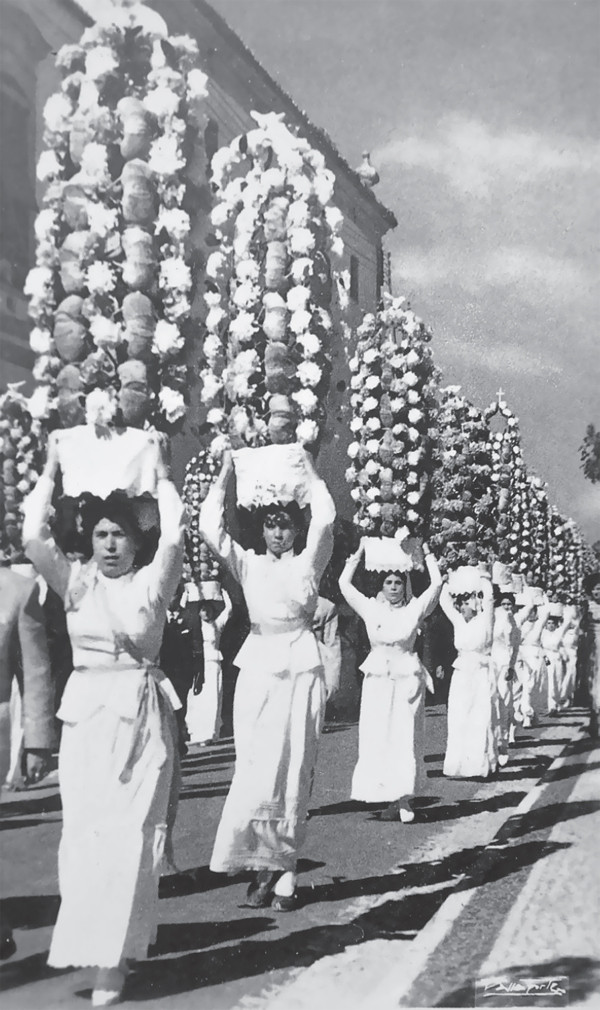51
PRESENT ERA. AKSUM. A FEAST DAY WHEN THE TABOTAT ARE SEEN IN DAYLIGHT . . .
The church of Our Lady Mary of Sion in Aksum claims to house the Tabota Zion, the Ethiopian name for the Ark of the Covenant.1 Copies of the Ark, or tabot, reside throughout other Coptic churches, particularly in the Lake Tana region, where the churches were built in circular fashion. The tabot spend much of the year resting behind a curtain of veils inside their inner sanctum. But for one special day their contents are brought out of the churches during Timkat, a feast celebrating the rite of baptism.
The feast of Timkat is referenced in the Bible and is still practiced throughout Ethiopia by black Jews who honor the Old Testament traditions, independent of later Judaism. During the celebrations the priests balance on their heads a stone tablet called a tabotat, a copy of the tablets contained within the Ark.2 These tabotat resemble trays, about fifteen inches square, each draped with a cloth embroidered with the emblem of a dove.
The ritual bears an uncanny similarity to an old Egyptian ceremony, the Festival of Apep, that took place in ancient times in a township by the Nile called Thebes, which back then was formerly called Tapet,3 a word sharing linguistic similarities with tabot. In this ceremony a miniature boat was carried on staves between the temples of Luxor and Karnak. The boat was curved much like the crescent moon, symbol of the god of wisdom, Djehuti; at its center rested a box-like repository inside of which was placed a sacred stone or veiled statues of gods made of stone.4 One scholar says of the connection between the ceremonial stone objects and the Ark, “The tradition of two sacred stone tablets within the Ark would point strongly to the conclusion that the original contents of the Ark must have been sacred stone . . . [which] was either conceived of as the deity himself, or as the object in which the deity was thought to reside permanently.”5
The original Ark would have passed through Thebes on its exodus from Jerusalem to Ethiopia, because its custodians built a temple to protect it on the island of Elephantine, to the south of Thebes.6
It would seem that Thebes is named for a celebration of the Ark, the memory of which was preserved in the form of a local folk tradition, while the event itself is depicted on the walls of the temple of Luxor.
Although no such mural exists in Tomar, its Feast of Tabuleiros records the memory of an event. Whether the Templars brought a copy of the Ark to Tomar is not possible to prove, but the remarkable thing is how an etymological trail connects these stories.
Linguistically, tabot descends from the Hebrew word tebah via the Aramaic tebuta, which refers to a container.7 Portuguese is a language rich in characteristics that reflect the myriad of peoples who settled in Portugal, such as Arabs, Jews, Egyptians, and particularly Phoenicians, whose language shares many common traits with Aramaic and old Hebrew. The Phoenician word thabilitho (a wooden slab), is also the origin of the Portuguese word tabuleiro; its variant, tablete, literally means “a tablet.”
Its first syllables, tabu, mean “something that is designated as sacred, set apart, or denoted as restricted.” Thus, the Feast of Tabuleiros in Tomar can be accurately described as “the feast of a tray on which rests a restricted holy or sacred object.”

The Feast of Tabuleiros in Tomar, during which women parade through town balancing a tabuleiro, a tall vertical shaft bearing thirty loaves of bread.

The visual symbolism of the Feast of the Tabuleiros bears an uncanny resemblance to the stella of Amun and the two oversized tablets of wisdom that make up his crown.